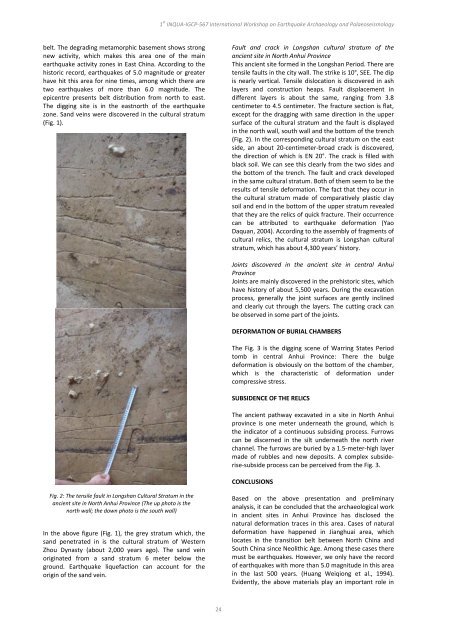Archaeoseismology and Palaeoseismology in the Alpine ... - Tierra
Archaeoseismology and Palaeoseismology in the Alpine ... - Tierra
Archaeoseismology and Palaeoseismology in the Alpine ... - Tierra
Create successful ePaper yourself
Turn your PDF publications into a flip-book with our unique Google optimized e-Paper software.
elt. The degrad<strong>in</strong>g metamorphic basement shows strong<br />
new activity, which makes this area one of <strong>the</strong> ma<strong>in</strong><br />
earthquake activity zones <strong>in</strong> East Ch<strong>in</strong>a. Accord<strong>in</strong>g to <strong>the</strong><br />
historic record, earthquakes of 5.0 magnitude or greater<br />
have hit this area for n<strong>in</strong>e times, among which <strong>the</strong>re are<br />
two earthquakes of more than 6.0 magnitude. The<br />
epicentre presents belt distribution from north to east.<br />
The digg<strong>in</strong>g site is <strong>in</strong> <strong>the</strong> eastnorth of <strong>the</strong> earthquake<br />
zone. S<strong>and</strong> ve<strong>in</strong>s were discovered <strong>in</strong> <strong>the</strong> cultural stratum<br />
(Fig. 1).<br />
Fig. 2: The tensile fault <strong>in</strong> Longshan Cultural Stratum <strong>in</strong> <strong>the</strong><br />
ancient site <strong>in</strong> North Anhui Prov<strong>in</strong>ce (The up photo is <strong>the</strong><br />
north wall; <strong>the</strong> down photo is <strong>the</strong> south wall)<br />
In <strong>the</strong> above figure (Fig. 1), <strong>the</strong> grey stratum which, <strong>the</strong><br />
s<strong>and</strong> penetrated <strong>in</strong> is <strong>the</strong> cultural stratum of Western<br />
Zhou Dynasty (about 2,000 years ago). The s<strong>and</strong> ve<strong>in</strong><br />
orig<strong>in</strong>ated from a s<strong>and</strong> stratum 6 meter below <strong>the</strong><br />
ground. Earthquake liquefaction can account for <strong>the</strong><br />
orig<strong>in</strong> of <strong>the</strong> s<strong>and</strong> ve<strong>in</strong>.<br />
1 st INQUA‐IGCP‐567 International Workshop on Earthquake Archaeology <strong>and</strong> <strong>Palaeoseismology</strong><br />
24<br />
Fault <strong>and</strong> crack <strong>in</strong> Longshan cultural stratum of <strong>the</strong><br />
ancient site <strong>in</strong> North Anhui Prov<strong>in</strong>ce<br />
This ancient site formed <strong>in</strong> <strong>the</strong> Longshan Period. There are<br />
tensile faults <strong>in</strong> <strong>the</strong> city wall. The strike is 10°, SEE. The dip<br />
is nearly vertical. Tensile dislocation is discovered <strong>in</strong> ash<br />
layers <strong>and</strong> construction heaps. Fault displacement <strong>in</strong><br />
different layers is about <strong>the</strong> same, rang<strong>in</strong>g from 3.8<br />
centimeter to 4.5 centimeter. The fracture section is flat,<br />
except for <strong>the</strong> dragg<strong>in</strong>g with same direction <strong>in</strong> <strong>the</strong> upper<br />
surface of <strong>the</strong> cultural stratum <strong>and</strong> <strong>the</strong> fault is displayed<br />
<strong>in</strong> <strong>the</strong> north wall, south wall <strong>and</strong> <strong>the</strong> bottom of <strong>the</strong> trench<br />
(Fig. 2). In <strong>the</strong> correspond<strong>in</strong>g cultural stratum on <strong>the</strong> east<br />
side, an about 20‐centimeter‐broad crack is discovered,<br />
<strong>the</strong> direction of which is EN 20°. The crack is filled with<br />
black soil. We can see this clearly from <strong>the</strong> two sides <strong>and</strong><br />
<strong>the</strong> bottom of <strong>the</strong> trench. The fault <strong>and</strong> crack developed<br />
<strong>in</strong> <strong>the</strong> same cultural stratum. Both of <strong>the</strong>m seem to be <strong>the</strong><br />
results of tensile deformation. The fact that <strong>the</strong>y occur <strong>in</strong><br />
<strong>the</strong> cultural stratum made of comparatively plastic clay<br />
soil <strong>and</strong> end <strong>in</strong> <strong>the</strong> bottom of <strong>the</strong> upper stratum revealed<br />
that <strong>the</strong>y are <strong>the</strong> relics of quick fracture. Their occurrence<br />
can be attributed to earthquake deformation (Yao<br />
Daquan, 2004). Accord<strong>in</strong>g to <strong>the</strong> assembly of fragments of<br />
cultural relics, <strong>the</strong> cultural stratum is Longshan cultural<br />
stratum, which has about 4,300 years’ history.<br />
Jo<strong>in</strong>ts discovered <strong>in</strong> <strong>the</strong> ancient site <strong>in</strong> central Anhui<br />
Prov<strong>in</strong>ce<br />
Jo<strong>in</strong>ts are ma<strong>in</strong>ly discovered <strong>in</strong> <strong>the</strong> prehistoric sites, which<br />
have history of about 5,500 years. Dur<strong>in</strong>g <strong>the</strong> excavation<br />
process, generally <strong>the</strong> jo<strong>in</strong>t surfaces are gently <strong>in</strong>cl<strong>in</strong>ed<br />
<strong>and</strong> clearly cut through <strong>the</strong> layers. The cutt<strong>in</strong>g crack can<br />
be observed <strong>in</strong> some part of <strong>the</strong> jo<strong>in</strong>ts.<br />
DEFORMATION OF BURIAL CHAMBERS<br />
The Fig. 3 is <strong>the</strong> digg<strong>in</strong>g scene of Warr<strong>in</strong>g States Period<br />
tomb <strong>in</strong> central Anhui Prov<strong>in</strong>ce: There <strong>the</strong> bulge<br />
deformation is obviously on <strong>the</strong> bottom of <strong>the</strong> chamber,<br />
which is <strong>the</strong> characteristic of deformation under<br />
compressive stress.<br />
SUBSIDENCE OF THE RELICS<br />
The ancient pathway excavated <strong>in</strong> a site <strong>in</strong> North Anhui<br />
prov<strong>in</strong>ce is one meter underneath <strong>the</strong> ground, which is<br />
<strong>the</strong> <strong>in</strong>dicator of a cont<strong>in</strong>uous subsid<strong>in</strong>g process. Furrows<br />
can be discerned <strong>in</strong> <strong>the</strong> silt underneath <strong>the</strong> north river<br />
channel. The furrows are buried by a 1.5‐meter‐high layer<br />
made of rubbles <strong>and</strong> new deposits. A complex subside‐<br />
rise‐subside process can be perceived from <strong>the</strong> Fig. 3.<br />
CONCLUSIONS<br />
Based on <strong>the</strong> above presentation <strong>and</strong> prelim<strong>in</strong>ary<br />
analysis, it can be concluded that <strong>the</strong> archaeological work<br />
<strong>in</strong> ancient sites <strong>in</strong> Anhui Prov<strong>in</strong>ce has disclosed <strong>the</strong><br />
natural deformation traces <strong>in</strong> this area. Cases of natural<br />
deformation have happened <strong>in</strong> Jianghuai area, which<br />
locates <strong>in</strong> <strong>the</strong> transition belt between North Ch<strong>in</strong>a <strong>and</strong><br />
South Ch<strong>in</strong>a s<strong>in</strong>ce Neolithic Age. Among <strong>the</strong>se cases <strong>the</strong>re<br />
must be earthquakes. However, we only have <strong>the</strong> record<br />
of earthquakes with more than 5.0 magnitude <strong>in</strong> this area<br />
<strong>in</strong> <strong>the</strong> last 500 years. (Huang Weiqiong et al., 1994).<br />
Evidently, <strong>the</strong> above materials play an important role <strong>in</strong>



